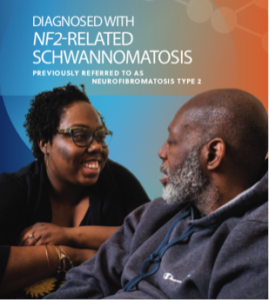Neurofibromatosis type 2 (NF2) - Related Schwannomatosis

Neurofibromatosis type 2 (NF2) - Related Schwannomatosis is much less common than NF1, affecting about 1 in 25,000 people worldwide. The disorder is characterized by the development of benign tumours, called vestibular schwannomas (formerly called acoustic neuromas), on the nerve that carries sound and balance information from the inner ear to the brain (the eighth cranial nerve). These tumours affect both ears, often leading to partial or complete hearing loss. People with NF2 may also develop other types of benign brain or spinal tumours. The disorder can also cause the development of cataracts or other eye findings, potentially compromising vision. Most people develop symptoms in the late teen and early adult years, although about 10% of people develop symptoms during late childhood.
The appearance of the most common signs of NF2 usually vary from person to person, but most begin experiencing their first symptoms during the late teenage years or early 20s. Nerve damage for individuals with NF2 may result in some, but not all, of the following:
- Ringing in the ears (tinnitus)
- Hearing loss
- Problems with balance
- Facial weakness
- Brain and cranial nerve damage
- Swallowing difficulties
- Seizures
- Vision loss
- Loss of balance and mobility, owing to
- Spinal tumours
- Peripheral neuropathy
- Muscle wasting
- Drop foot/foot drop
- Pain
NF2 is typically diagnosed by a neurologist or geneticist based on the presence of clinical findings documented during a clinical examination, MRI imaging, and a medical history discussion. Genetic testing for NF2 is available, but the condition cannot always be diagnosed through a blood test since the genetic mutation is sometimes only detectable in affected tumour tissues.
The diagnostic criteria for NF2 include:
- Bilateral vestibular schwannomas (affecting both ears)
- OR a first degree relative with NF2, PLUS:
- Unilateral (affecting one ear) vestibular schwannoma OR
- Any two of the following:
- Meningioma
- Glioma (for example, spinal ependymoma)
- Neurofibroma
- Schwannoma
- Juvenile cataracts
- OR unilateral vestibular schwannoma PLUS any two of the following:
- Meningioma
- Glioma
- Neurofibroma
- Schwannoma
- Juvenile cataracts
- OR multiple meningiomas (two or more) PLUS:
- Unilateral vestibular schwannoma, OR
- Any two of the following:
- Glioma
- Neurofibroma
- Schwannoma
- Juvenile cataracts
Once someone has been diagnosed with NF2, a number of tests may be helpful in defining the nature and progression of the disorder. These tests include the MRI (magnetic resonance imaging) scan and an audiometry, or hearing test. Often times, an ophthalmological (eye) exam is recommended. Genetic testing for NF2 can be done, but is a personal choice. It can be used to establish or confirm a diagnosis of NF2 when the situation is uncertain. A genetics healthcare provider or genetic counselor can help you make this decision.
At this time, possible treatments available for NF2-associated tumours include surgery, chemotherapy, and radiation therapy. However, the research being funded by the Children’s Tumor Foundation in New York, and its partners, is ongoing to identify improved candidate drug therapies that could lead to further treatments for NF2, such as those that enable the shrinking or stopping of the growth of tumours associated with NF2.

